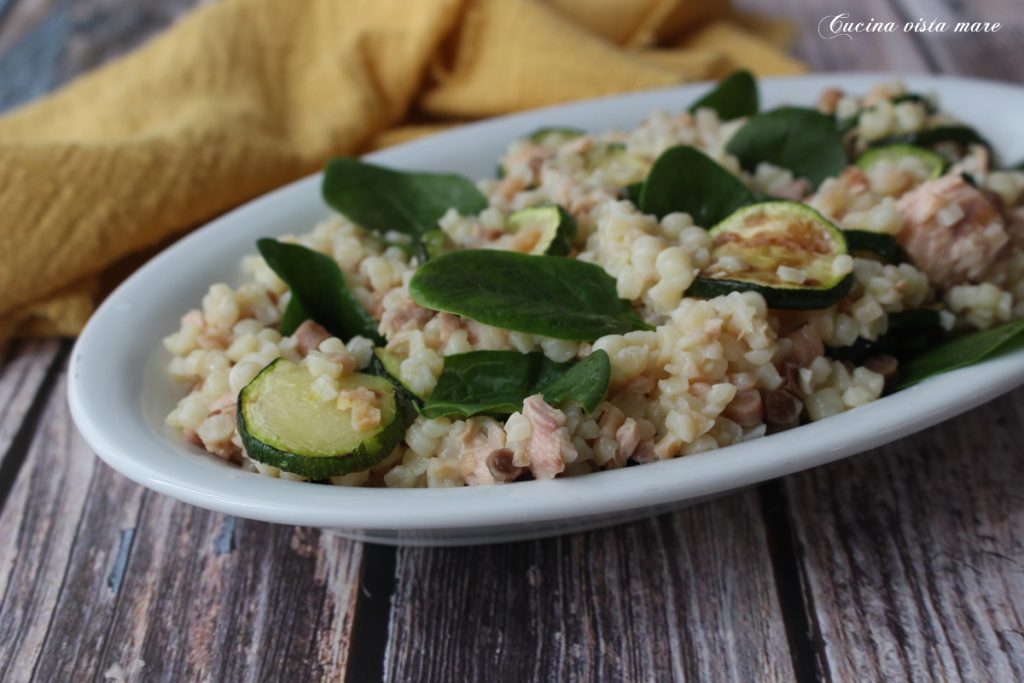Fregula with tuna, zucchini, and baby spinach is a simple, tasty, and light spring dish, perfect to enjoy at home, sitting at the table, but also convenient to take away for lunch on the go, at the office, at the beach, or for a picnic. It is also great served for a buffet because it is excellent to eat warm or cold, like a classic rice salad. So you have a versatile recipe to prepare exactly as I suggest or to personalize with the ingredients you prefer. Here, for example, I would have added some Taggiasca olives and corn. What would you add? Meanwhile, let’s see how to prepare fregula with tuna, zucchini, and baby spinach, and then feel free to bring all your ideas! But is it called fregula or fregola? And what cereal is fregula? Here I refer you down to the curiosities!
Don’t miss

- Difficulty: Easy
- Cost: Economical
- Rest time: 15 Minutes
- Preparation time: 30 Minutes
- Portions: 4 People
- Cooking methods: Stovetop
- Cuisine: Italian
- Seasonality: All Seasons
Ingredients
- 11 oz Sardinian fregula
- 7 oz tuna in oil
- 2 zucchini
- 3.5 oz fresh baby spinach
- 1 lemon
- 2 tbsp extra virgin olive oil
- to taste salt
Tools
- 1 Pasta Pot
- 1 Grill Pan
- 1 Mandoline
- 1 Bowl
- 1 Grater
Steps
Bring a pot of salted water to a boil and cook the fregula according to the package instructions. Once cooked, drain it, cool it under running water (if you want to prepare a cold dish), and set it aside. Wash and dry the zucchini, trim them, and slice them with the mandoline. Dress them with a drizzle of oil and grill them on both sides until you get the classic golden stripes. In a bowl, mix the fregula with the drained tuna, fresh baby spinach washed and patted dry with kitchen paper, and grilled zucchini. Add the lemon juice, a little grated zest, and season with oil and salt. Mix gently, let it rest for fifteen minutes at room temperature to allow the flavors to blend, and serve.
Curiosities
What type of cereal is fregula?
Fregula is a typical Sardinian pasta made from durum wheat semolina: they are crumbs of pasta obtained by ‘rubbing’ the semolina with salted water in a terracotta container with a continuous circular motion, gradually adding water to form crumbs that should neither be too dry nor too wet. Then it is dried by toasting it in the oven. It is also called Italian couscous due to its similarity, although the cooking methods are different. One is steamed, the other is boiled.
Is it called fregula or fregola? As taught by the Accademia della Crusca, fregola was an already existing term that already had its own meaning. Fregula is the exact Sardinian term, to put it briefly, but if you want you can read the whole article, from the Latin ‘fricare’, ‘frigare’ in Sardinian meaning to rub, which is the movement used to obtain this pasta. Fregola is Italianized from Sardinian, but it is a translation that purists do not like as it originally refers to something else.
According to some, fregula instead derives from the Latin ferculum meaning crumb.

